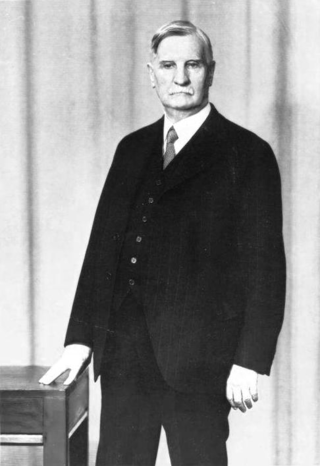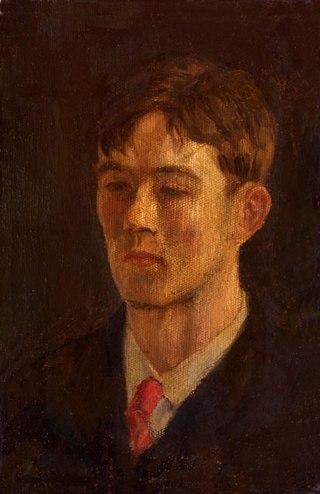The Pennsylvania Railroad, legal name The Pennsylvania Railroad Company, also known as the "Pennsy", was an American Class I railroad that was established in 1846 and headquartered in Philadelphia. It was named for the commonwealth in which it was established. At its peak in 1882, the Pennsylvania Railroad was the largest railroad, the largest transportation enterprise, and the largest corporation in the world.
Robert Strausz-Hupé was an Austrian-born American diplomat and geopolitical theorist.

Edward Gowen Budd was an American inventor and businessman.

The International Railway Journal (IRJ) is a monthly international trade magazine published by Simmons-Boardman Publishing in Falmouth, England.

Railway Age is an American trade magazine for the rail transport industry. It was founded in 1856 in Chicago and is published monthly by Simmons-Boardman Publishing Corporation.

John Walker Barriger III was an American railroad executive; he successively led the Monon Railroad, Pittsburgh and Lake Erie Railroad, Missouri-Kansas-Texas Railroad and the Boston and Maine Railroad. In 1969, he was chosen as Railroader of the Year by industry trade journal Modern Railroads.

Walter Emerson Baum was an American artist and educator active in the Bucks and Lehigh County areas of Pennsylvania in the United States. In addition to being a prolific painter, Baum was also responsible for the founding of the Baum School of Art and the Allentown Art Museum.
Charles Eugene Denney Sr. was president of Northern Pacific Railway from 1939 through 1950.

John Borland Thayer II was an American businessman who had a thirty-year career as an executive with the Pennsylvania Railroad Company. He was a director and second vice-president of the company when he died less than a week before his 50th birthday in the sinking of the RMS Titanic, on April 15, 1912. In his youth, Thayer was also a prominent sportsman, playing baseball and lacrosse for the University of Pennsylvania and first-class cricket for the Philadelphian cricket team. He is the only first-class cricketer known to have died aboard Titanic.

James McCrea (1848–1913) was the president of the Pennsylvania Railroad from 1907 to 1913.

The Gettysburg and Harrisburg Railway was a Pennsylvania line from near Carlisle southward to Gettysburg operated by a subsidiary of the Reading Company. The line also included the Round Top Branch over the Gettysburg Battlefield to Round Top, Pennsylvania until c. 1942.

Thomas DeWitt Cuyler was an American lawyer who served as director of the Pennsylvania Railroad and the chairman of the Association of Railway Executives.
The St. Louis, San Francisco and Texas Railway was a subsidiary railway to the St. Louis-San Francisco Railway (Frisco) operating 159 miles of railway line in Texas. The Frisco, including the subsidiary, formed a large X-shaped system across the states of Kansas, Missouri, Oklahoma, Texas, Arkansas, Mississippi and Alabama. It merged into SLSF at the beginning of 1964; SLSF merged into the Burlington Northern Railroad in 1980.

The St. Louis Southwestern Railway of Texas, operated the lines of its parent company, the St. Louis Southwestern Railway within the state of Texas. The St. Louis Southwestern, known by its nickname of "The Cotton Belt Route" or simply the Cotton Belt, was organized on January 12, 1891, although it had its origins in a series of short rail lines founded in 1870 in Tyler, Texas, that connected northeastern Texas to Arkansas and southeastern Missouri. Construction of the original Tyler Tap Railroad began in the summer of 1875. The St. Louis Southwestern of Texas merged with the property of the Tyler Southeastern Railway on October 6, 1899. The property of the Texas and Louisiana Railway was acquired and merged on July 2, 1903.
The lines of the Canadian Pacific Railway (CP) operated in the State of Vermont were set up as a separate company to comply with Interstate Commerce Commission regulations and were considered a Class I U.S. railroad. The company operated 90 miles (140 km) of railway in Vermont.
Walter Theodore Krausch, known as W.T. Krausch (1868–1929), was an American architect, engineer, and inventor who worked for the Chicago, Burlington and Quincy Railroad (CB&Q) from the late 1880s to the 1920s.
Railway Track & Structures (RT&S) is an American trade journal for the rail transport industry, focusing on the fields of railroad engineering, communication and maintenance. It was founded in 1905 as Railway Engineering & Maintenance and is published monthly by Simmons-Boardman Publishing Corporation.
Simmons-Boardman Publishing is an American publisher, specializing in industry publications. It is headquartered in New York City, New York, and has offices in Chicago, Omaha, and Falmouth, Cornwall, UK. The company was created from a merger of The Railroad Gazette and Railway Age in 1908; the company's name was derived from Gazette's vice president, E. A. Simmons, and editor, William H. Boardman.









